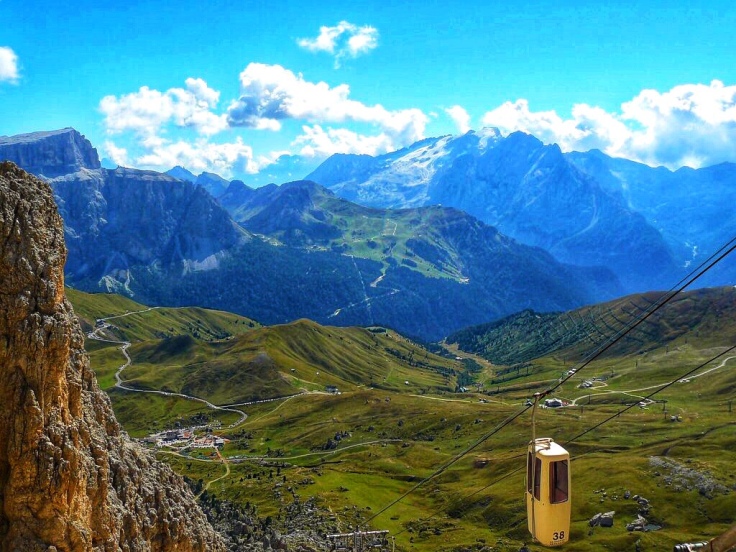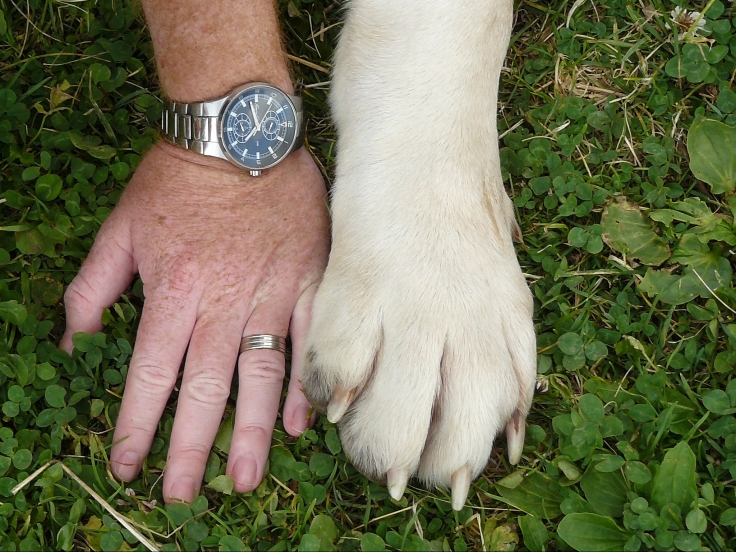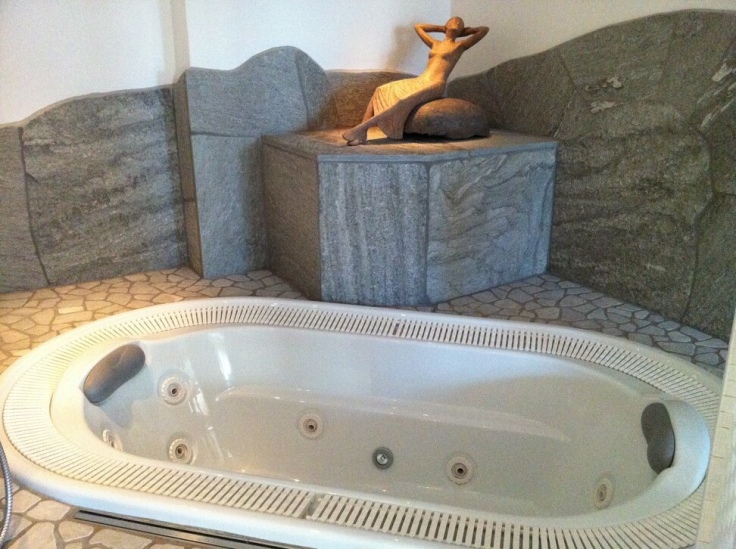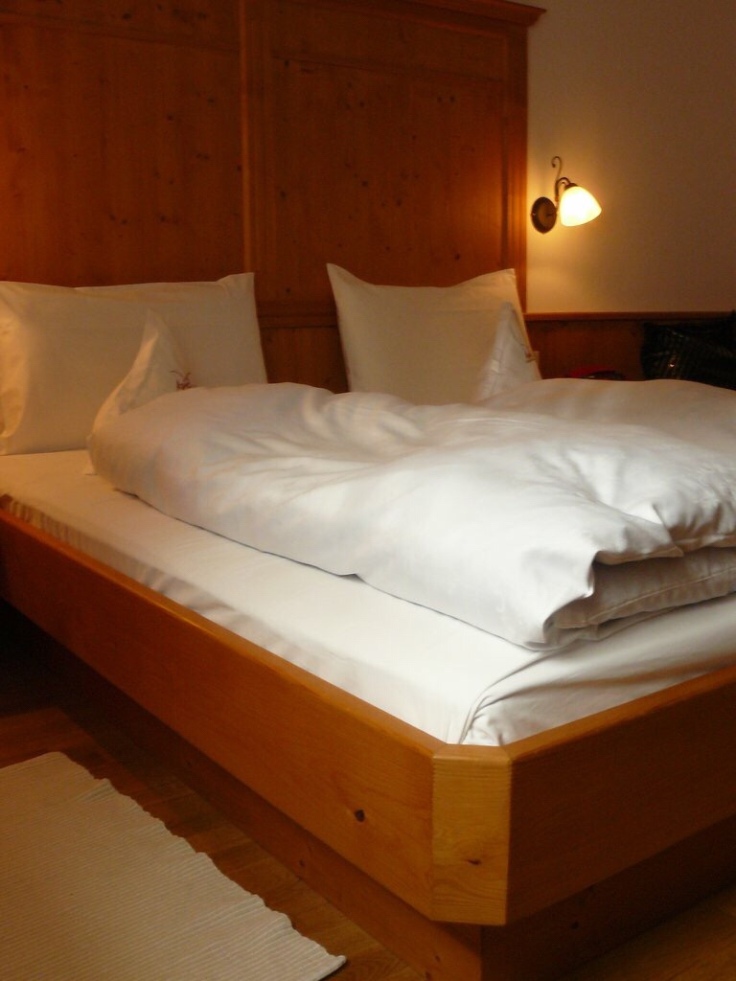“You may have the universe if I may have Italy.” – Giuseppe Verdi, Italian composer.
At 2,681 metres strange things can happen.

While we were admiring the sun glinting off the glacier of Mt Marmolada, Mr 77 got whacked in his privates with the pointy end of a Nordic walking stick.
I turned to exclaim at the beauty before us and wondered why he was bent over, breathless, muttering about war and yelling at a hapless German woman to watch what she was doing.
An interesting start to an unforgettable day and one of the lesser known perils of hiking, luckily the stunning Dolomites more than made up for the injury.

Forged around 100 million years ago, an accumulation of shells, coral and algae, the towering peaks of the Dolomites are often referred to as the pale mountains due to the dolomite rock (dolostone) shining white when it reflects the sun.

Looking out over the spiky peaks it is mind blowing to think you are staring at the remains of a vast primordial seabed. Deep within the folds of the mountain lie fossils of deep sea creatures, animals and plants that lived hundreds of millions of years ago.
The Dolomites are a place where the beauty of our world makes you catch your breath in wonder and where humankind’s insignificance is apparent as you stare at the millions of years of history before you.

Hiking & Adventure
The mountain trails around Selva Val Gardina offer spectacular views. The hiking, climbing and biking options are endless in the Unesco World Heritage area. The scenery at every turn is nothing short of breathtaking and the best part is, it’s a perfect place to relax for the whole family, including the family pooch !
Today, Mr 77 and I are tackling some trails around the Sassolungo Mountain Group.
The mountains are very different here, moonlike landscapes, mini glaciers, hidden waterfalls and endless views of the Alps stretch into the deep valleys below.

It is an ascent of 2681 meters from the base station at Passo Sella to the Toni Demetz Hut at the top of the Sassolungo Peak.
If you are feeling less energetic, there is also a cable car ride that takes you to the top.
The locals call them the love cars as they are tiny,only big enough to fit 2 people. You have to run and jump to get on the moving car and it is a heart stopping 15-minute ride up to the peak. At the top two burly men pull you out of the car before it turns to make its descent, it is a crazy ride but the views make it totally worth it.

I feel like I am on top of the world, looking down as para-gliders and birds float on wind currents and clouds float by within reach in the sky above.
There are a few brave souls rock climbing, climbing the via ferratas (iron ladders installed by soldiers during The Great War) to the peak and the cross at 3,181 metres.

We stop for morning coffee at the Refuge Demetz located at 2,881 metres. It is a clear day and great views of Mt Marmolada.
On today’s walk down the Sassolungo Mountain we not only stare in awe at the spectacular scenery, but are amazed that the family dogs are taken on hikes. Something foreign to us antipodeans as our National Park laws forbid it. Here though your dog can hike with you and is even allowed in the cable cars. We see a beautiful German Shepherd, Jack Russell, Wolfhound, Terrier and Retriever.

The descent is steep so we regularly stop to admire the view. When we arrive at the bottom hunger takes over and we eat at Refuge Sellajochhaus for the local dumplings as Mr 77 tucks into the spatzle. Both are delicious and filling after the walk.

Mr 77 and I take another gentle walk to see views over Mt Marmolada, it is an easy stroll and we are rewarded with amazing views.
We catch a bus to St Christina a pretty town at 1,428 metres. The local bus network is easy and efficient and transports hikers between the towns.

Mr 77 and I take the cable car up to Col Raiser a vantage point with 360 degree views around Mt Seceda, Col De Pieres and the Gran Fermeda. There is the Almhotel at the top of the cable car and we stop for some coffee and to say hello to the enormous St Bernhard whoese paws were the size of Neil’s hand.

Mr 77 and I walk until we find a beautiful view over the valley, where we sit and dream amongst the flowers and clover.

It feels like we are sleeping on top of the world in a stone palace as clouds pass below us and all we can see are the endless jagged peaks rolling on forever. It is a breathtaking dream.

Mr 77 decides that dinner tonight will be at Hotel Scoillato. After a solemn waiter greets us, I order grilled sea bass with vegetables. Mr 77 has pork with a cheese sauce and vegetables, I try the pfefferer wine which it is light and fruity. Mr 77 opts for beer. Like all the food in the valley it is wholesome and delicious.

It has been an exhausting day, our feet are tired and our legs weary, but hiking in the high altitudes rewards you with stunning views.
Luckily Mr 77 has also fully recovered from his earlier run in with a Nordic pole.
We go to sleep dreaming of floating stone palaces above ancient sea beds in candy floss clouds.
How to get there
Selva di Val Gardena is located in the province of Bolzano in the South Tyrol of Northern Italy. It lies at an altitude of 1563 m above sea level and has around 2600 inhabitants. This pretty town is surrounded by the mountains Sella and Sassolungo.
Train – You must catch the train to Bressanone or Bolzano, or Chiusa. A bus service will then transport you from Bressanone and Bolzano almost every hour to Val Gardena.
The Man in Seat 61 has the latest timetables, tips and train information in Italy.
Note that some hotels can arrange a pick-up service for you.
For other options, click on this link Ways to get to Selva di Val Gardena
Where to Stay
There are many hotels and B & B’s (known as Garni’s) to stay at in the region. Mr 77 and I stayed at a lovely B & B the Garni Aghel it was a very charming B&B that was family run. The hosts were friendly and informative. The rooms was a very comfortable double rooms that had lots of space for our bags. The gardens of the Garni were charming and breakfast was your standard European fair of pastries, juice, meat, cheese, boiled eggs and tea or coffee. They also have a spa/sauna facility that you could pay to use.
For a full list and reviews of the accommodation options in Val Gardena, click on the links below:
Bookings.Com – Accomodation in Selva Gardena
Trip Advisor Accommodation – Selva Gardena/Wolkenstein
 The Bathroom at the Gharni Aghel
The Bathroom at the Gharni Aghel
Where to Eat
We ate a couple of times at the Ristorante Pizzeria Sun Valley Restaurant – Strada Dantercepies 7, 39048, Selva di Val Gardena, Italy.
The wholesome fare of Sun Valley
Mr 77 and I really enjoyed the food. It is simple, hearty fare that fills you up after a day of hiking. I had a Crodino ( a bitters type drink) most nights and Mr 77 drank Weinghensteiner ( a German beer). We had dinner of lamb cutlets, vegetables, goulash, dumplings and sauerkraut. They also serve a delicious sweet dumpling filled with chocolate and dipped in coconut and they are just divine.
For a full listing of reviews of restuarants in the area, check out Restaurants in Selva di Val Gardena – South Tyrol Trentino Alto Adige

Val Gardena with the kids
Walking, riding, swimming, biking, skiing and snowboarding! Ride the funiculars, take the train or hike with the kids to see the spectacular scenery. It is the perfect paradise for active kids. Be sure to look for accomodation and places displaying a teddy bear sticker and ask for family discounts.
Teach the kids some
Ladin !
good morning! = bon dí!
good night! = bona nuet!
how are you? = co vala?
Novels set in the Dolomites

https://www.amazon.com/Beneath-Mountain-Novel-Luca-DAndrea/dp/006268017X

https://www.tripfiction.com/novel-set-in-the-dolomites/

https://www.amazon.com/Eight-Mountains-Novel-Paolo-Cognetti/dp/1501169882
FURTHER READING
History of the Dolomites
When the glaciers began to retreat, some 11,000 year ago, hunters began to move into the higher altitudes.
Archaeologists believe the area began to be inhabited in the Mesolithic period (9,000-4,500 B.C.); excavations show temporary lodgings and shelters for hunters at higher altitudes.

The first settlements of the region date back to the Middle Bronze Age (Sotćiastel – a fortified bronze age settlement that flourished between 1600 and 1400 B.C) and the Iron Age (Ortisei excavations).
Romanisation
The Romans launched campaigns in the Alps prior to their recorded victory in 15 BC, against the Raeti (alpine farming tribes that lived in Switzerland, the Tyrol, Italy and Germany) and the Vindelici (celtic tribes from Antiquity) on the plains where the Eisack and Adige rivers meet. The Roman prescence in the Alps saw the construction of important new roads, Roman law, new religion, the dominance of the Latin language, and from the fourth century AD, Christianity.
After the fall of the western Roman Empire and the migration of Germanic tribes, the region completely Germanised before the year 1000.
Middle Ages
When the Western Roman Empire fell, the main valleys became occupied by the Lombards and later the Bavarians; towards the end of the eighth century, Charlemagne conquered the entire region and incorporated it into France.
During this period, the feudal system and division into counties were introduced. In 1027, the Bishop of Brixen was appointed Lord of the Inn and Eisack districts by the Emperor. In 1091, he was also granted the Puster Valley and Val Badia. The bishop delegated management rights and districts to refined and influential families, often the subject of controversy.
Val Badia was divided into two domains: the left side of the valley belonged to the Lordship of Tor and thus to the bishop of Brixen, the right side belonged to the bishop, but was also run by the Benedictine nuns of Sonnenburg (the Sonnenburg was known as Ćiastel Badia, which is why the entire valley was also called Val Badia).
In 1363, the whole of Tyrol (the principalities of Brixen and Trento) was assigned to the Hapsburg Empire. Ampezzo was also occupied by Tyrolean troops in 1511 and became part of Austria, as did the remaining Ladin valleys. This later changed under Napoleon.
The Napoleonic era
During the Napoleonic Wars in 1806, Tyrol passed to Bavaria and, in 1809, the Ladin population took part in Andreas Hofer’s revolt to liberate the Tyrol.
In 1810, Ampezzo, Colle Santa Lucia, Livinallongo del Col di Lana, and the Val di Fassa were incorporated into the Kingdom of Italy by Napoleon.
World War and Fascism
The First World War tore the Ladin areas apart. The Dolomite front ran through the centre of the Ladin valleys. More than 1,050 Ladin people died in the conflict and a number of villages, especially in Livinallongo del Col di Lana, were almost completely destroyed. After the war, unfavourable circumstances continued because South Tyrol, and thus also the Ladin areas, were in Italian territory.
In 1922, the fascist party in power launched a policy of forced Italianisation.
The Ladin population was assigned three different provinces: the Val Badia and Val Gardena to the province of Bolzano, Livinallongo del Col di Lana and Ampezzo to Belluno, and Val di Fassa to Trento. The Ladin people came under pressure between two movements. On one side was fascism – on the other, Nazism; the latter drew up a strategy to resolve the problems of minorities (Ladin peoples and the German-speaking population of South Tyrol), known as the Option (1939).
The non-Italian part of South Tyrol was asked to move to the German Reich, thus to leave their homes, or accept and implement the Italianisation of Tyrol.
The implementation of the Option was slowed by the outbreak of World War II, and completely abandoned on September 8, when the Pre-Alps zone of operations was established (all three provinces mentioned were managed by Hitler’s Germany). After the surrender, these territories came back under Italian rule.
The post-war period
In 1946, around 3,000 Ladin people met at the Sella Pass to protest against the splitting into three provinces implemented by the new Italian government following the fascist division.
However the demands of the Ladin population went unheeded. In 1948, small steps for recognition were made with the first version of a statute of autonomy for the provinces of Bolzano-Trento. It was not until 1972 with the the second Statute of Autonomy ithat provided a solid foundation for the official recognition of the Ladin people, teaching the Ladin language in schools, the right to Ladin place names, and for media in their native language. Over time, these minority rights were slowly expanded, but unfortunately only for the Ladin people in the provinces of Bolzano and Trento: Ampezzo, Livinallongo del Col di Lana, and Colle Santa Lucia have not been able to aspire to these successes so far.
The Ladin culture
The Ladin people are trilingual from around 4-5 years, children already understand three languages – Ladin, Italian and German. In addition, the English language is taught from the first years of elementary school. The Ladin language is a bridge between the Latin and Germanic languages.
The Ladin cuisine is the best of the Austrian-Hungarian and Italian cuisine.
Specialities of the region include I crafuncins: Tyrolean ravioli filled with spinach, tossed in melted butter, double cooked to lightly brown (never burned!), with parmesan or zigher cheese.

Then there is the dumplings!
The dumplings of the Dolomites are unforgettable. I still dream of them; there are the savoury ones: Dumplings with Speck in broth, with goulash and salad. Dumplings with cheese, with spinach in melted butter and Grana cheese.
Then they are the sweet ones filled with chocolate and rolled in coconut.
Dumplings are a serious business and local tradition holds that you should NEVER cut the dumplings with a knife or fork. They should be gently broken apart with a spoon and fork!
History source – Uniun Ladins Val Badia




Wonderful words Trudy xx
LikeLike